It was Memorial Day 2020, and I was not sailing. Our Classics Fleet at Oakcliff Sailing in Oyster Bay, New York was restricted by social distancing and masks. All I could do for recreation was walk. It was as eerily quiet on the water as it was in the deep of The Ramble in New York City’s Central Park. I was walking daily during the spring of 2020, and realized I was not walking by myself; I had a soundtrack around me. That was the birds of Central Park, thousands and thousands of them. It was then that I added birding, birdwatching, to my outdoor fitness regimen.
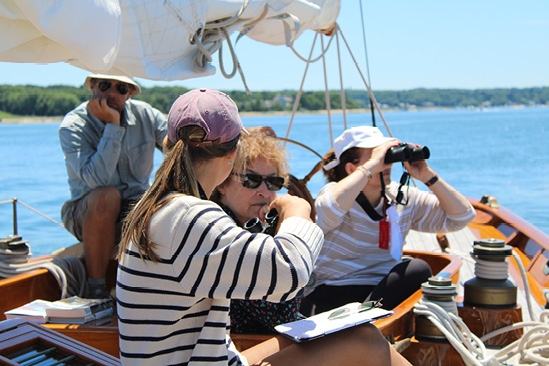
Birding aboard Chicane © Sean Duclay
The Centre Island Bird Sanctuary and the Stirling Harbor Foundation
A couple of years later in the same Oyster Bay that harbors the Oakcliff Classics, the newly formed Centre Island Bird Sanctuary (CIBS) emerged as a creative collaboration of the patrons of the Classics. By combining the rewarding activity of birdwatching with the enjoyment of vintage wood boats, CIBS is bringing the birds to boaters by taking boaters to the birds.
The parent organization of CIBS is The Stirling Harbor Foundation (SHF), which “aims to promote and preserve classic maritime history and nautical skills through restoring, maintaining and sailing historic vessels.” SHF which has created a program of tours and education that supports the passions for birds and classic boats working together. At the center of it all is a 24-year-old avian enthusiast with a dedicated sailing habit. A 2023 graduate of the College of Charleston, she is Emmi Triplett. Her mission is to lead tours from the decks of classic boats to “bird,” to explore, to educate, and hopefully to inspire a level of understanding and dedication to help the Sanctuary play its highest and best role in the great chain of being with birds… and boats.
As an undergrad, Emmi had a very practical reason for choosing birds; her first interest as a Biology major in the midst of the pandemic was fish. Being in close proximity to open South Carolina salt water was perfect for pelagic study, but she switched to birds. Why?
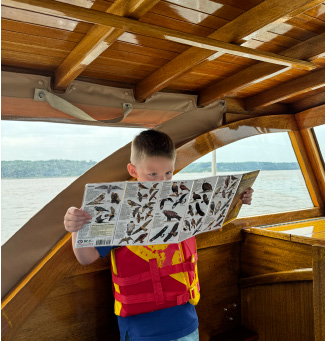
Anticipating an osprey sighting, a young birder studies a raptor guide aboard Tartan. © Emmi Triplett
It was all about the importance of not intruding in the natural landscape. “The advantage of studying birds is that you can see them,” says Emmi. “It’s passive. To study fish, you have to take them out of the water and they are stressed. Not so with birds; you look with binoculars and don’t disturb them.”
In the past two summers, Emmi has explored a wide variety of avian habitat, from tidal flats to beaches on Centre Island to the coastal groves of Sagamore Hill, the summer home of another ardent birder, President Teddy Roosevelt. A team comprising boat driver Jeff Truelove and tour leader Emmi brings boaters to birds from a variety of floating platforms. The tour boats range from a 100-year-old Scottish design to the ongoing project of a reproduction of a Herreshoff steam launch.
Birding, West and East
There ae two primary regions that CIBS studies, and they are seasonal. Summer means viewing the widest variety of birds from majestic ospreys in the trees to shorebirds on sand to ducks. This activity covers the acres of waterfront that stretch from Cold Spring Harbor in the east to Bayville in the western reaches of Oyster Bay.
Summer birdwatching is done primarily from Chicane, a 1926 Scottish sailboat. Chicane’s designer, Alfred Mylne, was one of a trio of leading Glasgow designers from the Scottish Renaissance (Mylne, C L Watson and the Fife family; see “Scottish Yachting” in the May and June editions of this magazine).
The Stirling Harbor Foundation acquired the 56-foot Chicane from a Bermuda-based owner who had done a complete restoration. According to the broker’s listing, the late Olin Stephens considered the restoration the finest he had ever seen. She looks like a traditional English cutter that you would see on the Clyde, but her relatively shallow draft (7’ 3’’), stability (26 tons) and ample cockpit make her ideal for a birding platform.
Despite her size, halfway between an 8 Metre and a 12 Metre, Chicane can reach all of the local spots, up into Cold Spring Harbor to the east and around Cove Neck where Roosevelt had a home. Travelling west through the Oyster Bay anchorage, she can gunkhole into West Harbor. The CIBS tours also utilize the traditional lobster boat designs owned by the Lawrence family of Centre Island. Dr. Betsy Lawrence led the effort to establish the Centre Island Bird Sanctuary.
In mid-October, the birding fleet goes east to its wintering grounds near its home boatyard in Stirling Harbor in Greenport, itself a hub for classic boat restoration at the end of Orient Point. The flocks are different, water birds primarily, thousands of ducks. The major skyways, the bird migration paths, pass right over Orient Point and Oyster Bay, running southwest from the Arctic.
I know that in the last five years I had seen the increase in the duck population in Central Park’s Onassis Reservoir. One now sees prehistoric-looking mergansers jockeying with amusing diving ducks like buffleheads. Where there were a few dozens, now there are thousands of ducks…and the infernal Canada geese cohabitating on duck water.

Chicane is a beautiful birding platform. © Tom Darling
Let’s Go Birding
Emmi explains that CIBS tours are booked online and here in season 3 they have become very popular. In early May, all but four seats for the sessions were sold. In addition to Chicane, which can carry six to eight birders, is a pair of lobster boat designs on which you can see Emmi and a group of birders fanned out in the cockpit with field guides and binoculars. Emmi address them while keeping her own experienced eye open for elusive species.
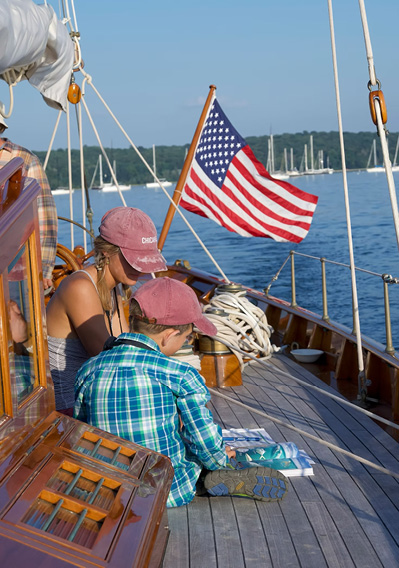
Citizen scientists at work aboard Chicane © Philip Giovannelli
The mission is to spot, identify, and record. It’s a game of numbers, a little like a trading floor for avian sightings. Emmi sits midships with her binoculars and what she calls a tally sheet. When a birder makes a positive identification, Emmi logs it in her sheet and then submits them to a worldwide research site called ebird, a real-time database of what is going on with birds…thousands, millions of birds. The idea is to make participants citizen scientists, says Emmi, to inspire and get people involved.
I asked Emmi about the distinction between birding and birdwatching. “Birdwatching is passive,” she explains. “You just watch. This is calm fun with binoculars and a field guide with identifying pictures, with minimal engagement. Birding is diving into the whole immersive process of viewing and data recording. It is intense. We want to encourage birding, make it fun. That’s a mission that goes hand in hand with that of the Stirling Harbor Foundation.”
Every Thursday, in partnership with SailAhead, an amazing organization co-founded by brothers Kilian and Sean Duclay, CIBS volunteers are also bringing birding to a new audience of returned military veterans. On the SailAhead website (sailahead.org), a former U.S. Army Ranger describes how experiences like birding provide a sense of purpose that eases the challenges of transitioning to civilian life. “It’s really hard,” says Matt, “but building community helps – especially when we’re doing things like this.”
Enter the Osprey
I asked Emmi which is her favorite bird. With no hesitation, she said the osprey. Sometimes known as the fish hawk, this bird is a familiar sight to Northeast boaters. We all see the raised wooden platforms provided for nesting. One nest I have seen nestles in the track fencing of Amtrak’s Acela passing Stonington, Connecticut. Emmi’s enthusiasm for the osprey is such that she can describe this unique raptor down to the unique architecture of its claws that make it a such proficient hunter of fish.
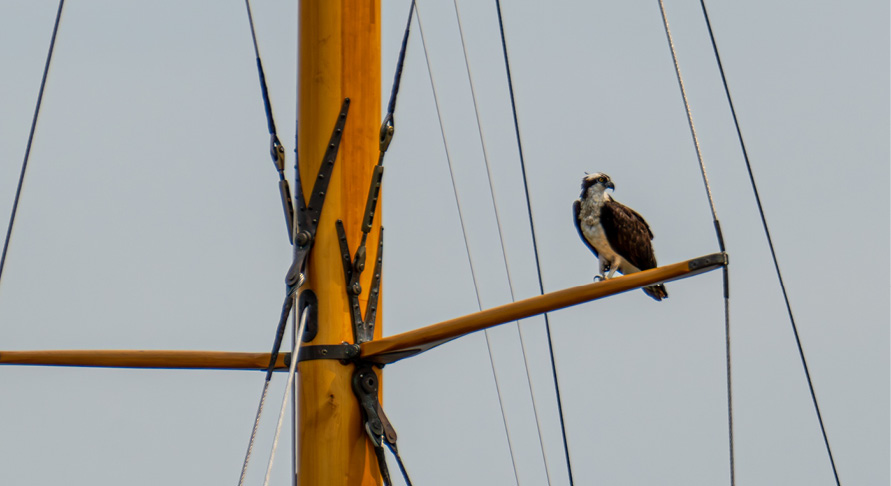
An osprey perches on Chicane’s spreader. © Tod Davis
Emmi and I discussed the modern history of the osprey and how its revival tracks the environmental movement of the last seventy years. It was the study of osprey egg shells and their thinning, associated with the spraying of toxic DDT, that pushed Rachel Carson to write the classic Silent Spring. Ospreys, ubiquitous on the coastline from Canada to Florida, had virtually vanished. As the spraying was reduced, the health of the birds and their eggs increased. The creation of artificial nesting sites was another contributor to the osprey’s return. I often check the osprey cams on nests in Nantucket, hoping to see the fuzzy ball heads of the young on the stand. Watching their mature relatives divebomb a fish their own size is thrilling.
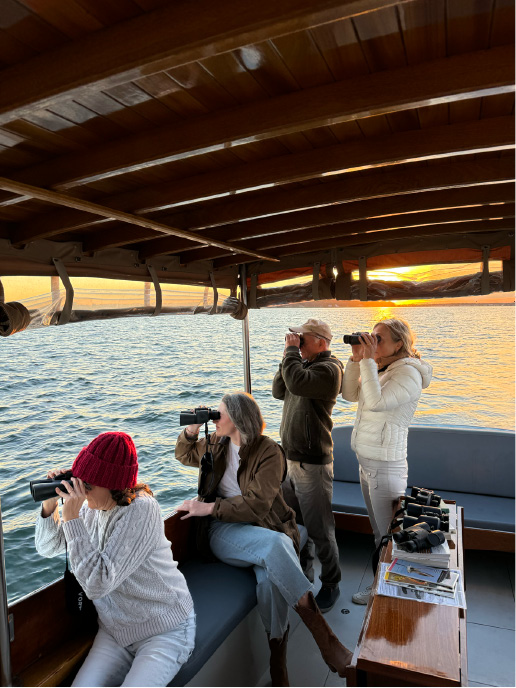
A winter duck tour on Tartan © Emmi Triplett
The Guides to the Birds
Like boating, birding has its literature to be studied. The National Audubon Society reported recently that the number of “Birding Enthusiasts” took a jump during COVID. Being outdoors and socially distanced is perfect for a birder. The Sibley Guide to Bird Life and Behavior is one of several comprehensive guides to the avian world. The bird statistics and the color illustrations are absorbing.
Emmi also prescribes Merlin Bird ID (merlin.allaboutbirds.org), the product of the Cornell Department of Ornithology. To identify that hidden bird, you just record a snipper of bird call and you are served up the name and genus of the bird in question.
According to the National Geographic Regional Guide, 374 bird species can be seen within 50-100 miles of Central Park. Their estimate for the spring migration is that 3.7 billion birds move down the corridor between the Arctic and the Mid-Atlantic regions.
Our POTUS Birder
Right in Emmi’s summer backyard lived a credentialled Presidential birder. Teddy Roosevelt was an active birder, at home in Oyster Bay and on his many foreign adventures. Biographer Edmond Morris claimed that the call of birds soothed him as a nearsighted youth and as a post-political naturalist. In Colonel Roosevelt, we see TR after his presidential career. On one hand, he took on quite dangerous expeditions in the heart of the steamy Mato Grosso in the remotest reaches of South America. Back at his home on Sagamore Hill, he prized his ability, honed in childhood, to identify his Cove Neck birds.
Unlike his cousins and uncle, TR did not take much to boats and salt water in Oyster Bay. “He had a tin ear for music,” Morris wrote, “but picking out individual birds was his gift…the Colonel’s savage beast was as often soothed by the bird music he heard at Oyster Bay, spring after warming spring.”
Morris captured the President’s kinship with all those birds, not different than a sailor and boats: “There is nothing that quite corresponds to the chorus that during May and June moves northward from the Gulf States and Southern California to Maine, Minnesota, and Oregon, to Ontario and Saskatchewan; when there comes the great vernal burst of bloom and song…when from the Atlantic seaboards to the Pacific, wood-thrushes, wearies, rufous-backed thrushes, robins, bluebirds, orioles, thrashers, catbirds, house-finches, song sparrows and many, many other singers thrill the gardens at sunrise, until the long days begin to shorten, and tawny lilies burn by the roadside and the indigo buntings trill from the tops of little trees throughout the hot afternoons.”
From the treetops to the shoreline, TR was what Emmi calls a citizen scientist, dedicated to the world of birds.
A Growing Fleet for the Sanctuary
We asked what’s next for CIBS. The answer is the launching of a new viewing platform, like Chicane with classical features but smaller and more maneuverable. That might be a reproduction of a genuine Herreshoff steam launch. From his first days at the Herreshoff Manufacturing Company in Bristol, Rhode Island, Captain Nat Herreshoff was enamored of stylish and swift power launches, propelled first by steam, then naptha and eventually gasoline.
Will electrons provide propulsion for the new CIBS launch? That would make it a seagoing golf cart good for a day’s birding, and the birds won’t get scared. I told Emmi I’d be back to find out. As for me, I got a new pair of Nikon binoculars for Christmas. I look forward to spying on ducks in NYC and on the salt water out east in Greenport. Ahoy, you birds! ■
Not a formally trained historian nevertheless a boat storyteller, collecting and reciting stories for the boating curious, Tom Darling hosts Conversations with Classic Boats, “the podcast that talks to boats.” Tune in via Apple Podcast, Google Podcast or Spotify, or online at conversationswithclassicboats.com.

